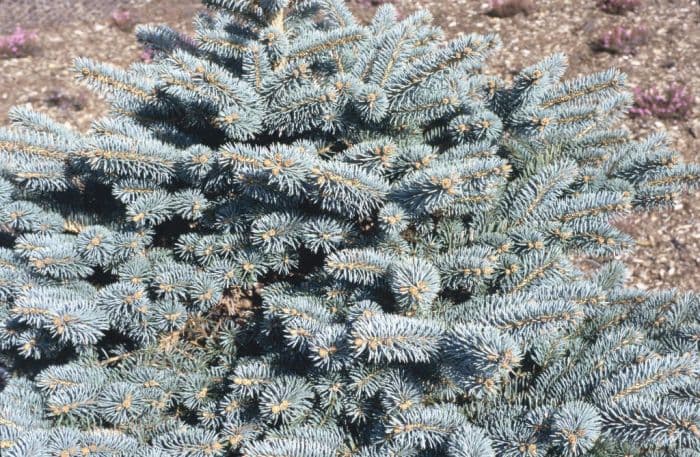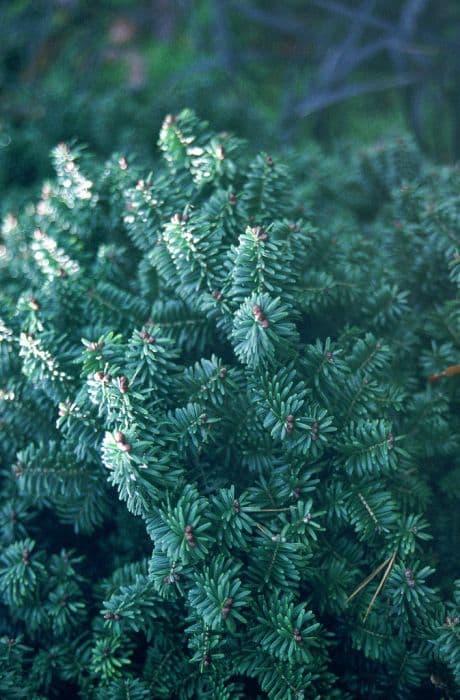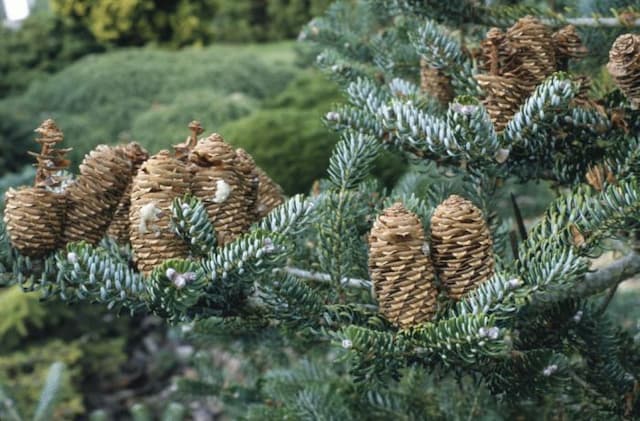Globe Blue Spruce Picea pungens (Glauca Group) 'Globosa'

ABOUT
The plant in question, commonly known as the Globe Blue Spruce, is an ornamental evergreen conifer notable for its distinctive shape and coloration. It boasts a dense, globe-like form with a rounded and compact nature. The foliage consists of striking steel-blue needles that are sharply pointed, giving the plant its characteristic hue and textural appearance. These needles are arrayed spirally on the branches, which are stout and robust, emanating from the center of the plant in a uniform manner, enhancing its spherical silhouette. The color remains year-round, providing a persistent splash of blue in the landscape across the seasons. The plant's overall appearance is one that exudes a sense of solidity and structure, often serving as a focal point in garden design thanks to its pronounced color and form. With its distinctive color palette, the Globe Blue Spruce is highly prized for its ability to add visual interest and contrast to gardens, often utilized in rock gardens, foundation plantings, or as a specimen ornament in various landscaped settings.
About this plant
 Names
NamesSynonyms
Globe Blue Spruce, Globe Colorado Blue Spruce, Dwarf Globe Blue Spruce, Globosa Spruce
Common names
Picea pungens (Glauca Group) 'Globosa'
 Toxicity
ToxicityTo humans
The plant commonly known as Colorado Blue Spruce is not considered highly toxic to humans. Ingesting any part of the Colorado Blue Spruce is not typically associated with serious poisoning. However, handling the plant may cause skin irritation or allergic reactions in some individuals due to the presence of resin or oils. If ingested in large quantities, the needles of the plant may cause stomach irritation or discomfort, but serious symptoms or fatalities are rare.
To pets
The Colorado Blue Spruce is generally considered to be of low toxicity to pets. Ingesting the needles may lead to mild gastrointestinal discomfort, such as vomiting or diarrhea, particularly if consumed in large amounts. The sharp needles can also cause physical irritation to the mouth and stomach if chewed or swallowed. However, serious cases of poisoning from this plant are uncommon. Owners should still prevent pets from ingesting this plant to avoid potential health issues.
 Characteristics
CharacteristicsLife cycle
Perennials
Foliage type
Evergreen
Color of leaves
Blue-green
Height
3 feet (0.91 meters)
Spread
4 feet (1.22 meters)
Plant type
Tree
Hardiness zones
2-8
Native area
North America
Benefits
 General Benefits
General Benefits- Aesthetic Appeal: Adds visual interest to landscapes with its dense, globe-shaped form and silvery-blue needles.
- Drought Tolerance: Once established, it requires minimal watering, making it suitable for xeriscaping.
- Cold Hardy: Thrives in cold climates, capable of withstanding harsh winters.
- Low Maintenance: Requires little pruning or additional care once established, making it an easy-to-care-for choice for gardeners.
- Erosion Control: Its root system helps stabilize the soil and prevent erosion, especially on slopes.
- Wildlife Habitat: Provides shelter and nesting sites for birds and other wildlife.
- Long-Lived: Is known for its longevity, providing decades of enjoyment in a landscape.
- Adaptable: Can grow in a variety of soil types, though it prefers well-drained soils.
- Compact Size: Its relatively small size makes it suitable for urban gardens and spaces where a full-sized blue spruce would be too large.
 Medical Properties
Medical PropertiesThis plant is not used for medical purposes.
 Air-purifying Qualities
Air-purifying QualitiesThis plant is not specifically known for air purifying qualities.
 Other Uses
Other Uses- The compact size of the Colorado blue spruce 'Globosa' makes it suitable as a container plant on patios or balconies, where space is limited.
- Its resistance to cold and unique shape can be utilized in theme gardens, such as miniature landscapes or fairy gardens.
- Due to its dense foliage, it's often employed in garden settings as a privacy screen or windbreak.
- The striking blue needles offer an appealing contrast in rock gardens, which generally lack such vivid colors.
- The slow growth habit of 'Globosa' makes it a suitable candidate for bonsai cultivation.
- It can be used in holiday decorations and wreaths outside of the traditional Christmas season due to its shape and evergreen nature.
- Its symmetrical form makes it an excellent choice for creating focal points or accents in formal garden designs.
- Colorado blue spruce 'Globosa's sturdy branches can support garden ornaments or lights, integrating it as part of garden art.
- In areas where snowfall is common, its branches can serve to catch snow and create natural sculptures in the winter garden.
- The tree can function as a backdrop for outdoor photography, providing a consistent and professional-looking setting throughout the year.
Interesting Facts
 Feng Shui
Feng ShuiThe Colorado Blue Spruce is not used in Feng Shui practice.
 Zodiac Sign Compitability
Zodiac Sign CompitabilityThe Colorado Blue Spruce is not used in astrology practice.
 Plant Symbolism
Plant Symbolism- Endurance and Strength: The Picea pungens, commonly known as the Colorado Blue Spruce, often endures harsh conditions and can live for hundreds of years, symbolizing resilience and the ability to withstand challenges over time.
- Peace: Evergreens like the Colorado Blue Spruce are often associated with peace and tranquility, perhaps due to their year-round presence and calming blue-green hue.
- Protection: Historically, spruce trees have been thought to offer protection, likely due to their sturdy nature and the shelter they provide in nature.
- Hospitality: The Colorado Blue Spruce's inviting evergreen appearance makes it a symbol of hospitality, welcoming others with its enduring spirit.
- Christmas and Celebration: Given its common use as a Christmas tree, the Colorado Blue Spruce is associated with the festive season, celebration, and bringing joy into homes.
 Water
WaterThe Dwarf Blue Spruce requires moderate watering, especially during dry spells, with a deep watering every couple of weeks. When the top 3 inches of soil feel dry, it's time to water again, aiming for the soil to be moist but not waterlogged. Each watering session should involve roughly 1-2 gallons of water for young plants, increasing as the tree matures based on its size and the local weather conditions. Avoid frequent shallow waterings, as they may encourage shallow root development, which can weaken the plant.
 Light
LightThe Dwarf Blue Spruce thrives best in full sun conditions, needing at least 6 hours of direct sunlight each day. It should be planted in a spot where it can receive unobstructed sunlight to maintain its distinct blue-tinged foliage and healthy growth. Partial shade is acceptable but may result in a less dense growth habit.
 Temperature
TemperatureThe Dwarf Blue Spruce is hardy and can withstand cold temperatures down to about -20°F, which makes it suitable for many temperate climates. This spruce prefers cooler environments and is able to tolerate a maximum temperature of around 70°F to 80°F. The ideal temperature for this plant is between 30°F and 60°F for optimal growth and health.
 Pruning
PruningThe Dwarf Blue Spruce typically requires minimal pruning, mainly to shape the plant or to remove dead or damaged branches. The best time to prune is in late winter or early spring before new growth begins. Pruning should be done sparingly as this plant is slow-growing and may not recover quickly from heavy trimming. Prune no more than once per year to maintain its natural globe shape.
 Cleaning
CleaningNot needed
 Soil
SoilThe Colorado Blue Spruce 'Globosa' prefers well-drained soil with a slightly acidic to neutral pH between 6.0 and 7.0. A soil mix of loamy soil, peat, and sand in equal parts works well to provide the necessary drainage and aeration.
 Repotting
RepottingColorado Blue Spruce 'Globosa' being a slow-growing dwarf conifer seldom needs repotting. It typically should be repotted every 3-5 years, or when it outgrows its current container.
 Humidity & Misting
Humidity & MistingColorado Blue Spruce 'Globosa' thrives best in low to moderate humidity typical of outdoor conditions. It is well-adapted to withstand seasonal variations in humidity levels.
 Suitable locations
Suitable locationsIndoor
Not ideal for indoor; requires full sun, cold winter.
Outdoor
Plant in full sun, well-drained soil; tolerate cold, drought.
Hardiness zone
2-7 USDA
 Life cycle
Life cyclePicea pungens (Glauca Group) 'Globosa', commonly known as Blue Spruce 'Globosa', begins its life as a seed, typically starting germination in the spring under suitable moisture and temperature conditions. The seedling stage follows germination, where the young spruce establishes a root system and begins to develop needles in its characteristically dense, globular form. In the juvenile stage, the 'Globosa' continues to grow slowly, maintaining its compact, rounded shape while increasing in size and developing a woody stem. Once reaching maturity, which can take several years, the Blue Spruce 'Globosa' produces cones for reproduction; male cones release pollen while female cones catch pollen to fertilize the seeds within. Upon reaching its mature size—which is smaller than typical Blue Spruces due to its dwarf nature—the plant maintains its size and can live for many years, with limited annual growth. Finally, the Blue Spruce 'Globosa' enters a stage of senescence where growth ceases, and the plant may eventually succumb to environmental stressors or old age.
 Propogation
PropogationPropogation time
Early Spring
The Colorado blue spruce (Picea pungens (Glauca Group) 'Globosa') is typically propagated by seed or cuttings, with cuttings being the most popular method among gardeners and professionals. This variety tends to be grafted onto rootstocks as a means to maintain the 'Globosa' shape and characteristics. The best time for taking cuttings is in late summer or early fall. Semi-hardwood cuttings, which are partially mature wood from the current year's growth, are taken from healthy parent trees. The cuttings should be about 4 to 6 inches (10 to 15 centimeters) long. To encourage rooting, the base of the cutting is treated with a rooting hormone before being planted in a well-draining soil mix. The cutting is then kept under appropriate conditions with consistent moisture and humidity until roots develop, which can typically take several weeks to a few months.









